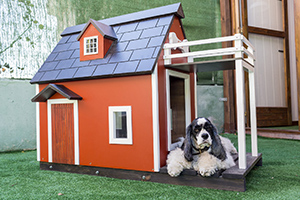Home Improvement More Essential Than Ever
“Out of adversity comes opportunity.”
Adversity hit hard in 2020, but home improvement is one of several industries making the most of the opportunities created by the coronavirus pandemic. And the momentum shows few signs of slowing down in 2021.
The pandemic has taught us many lessons. Probably one of the most important is the importance of home and family. When health organizations and governments shut down societies to curb the spread of the virus, homes became remote workplaces, classrooms, gyms, and entertainment centers.
Opportunities from adversity
To accommodate all these additional uses, and with a lot of extra time spent at home for American workers, the preponderance of DIY projects spread as rapidly as a virus.
A North American Hardware and Paint Association (NHPA) survey of 700 domestic home improvement stores showed that 87% of them reported growth of 24.2% because of the pandemic. Overall, the industry grew 19.4% from the start of the pandemic to the end of 2020.
Being designated an essential industry, which allowed stores to keep their doors open, certainly sparked the industry growth. And, according to the Home Improvement Research Institute (HIRI), brick–and–mortar stores accounted for anywhere from 80% to 90% of home improvement project sales.
Circumstances have also played a huge role in the home improvement boom.
Urban flight kicked into warp drive when large corporations sent their workers home. Many companies chose to make remote work permanent which has prompted many American workers to seek more rural, family-friendly, and less expensive homes and lifestyles. National Association of Realtors statistics show that existing home sales in December 2020 reached their highest levels in 14 years. Aiding the flight is historically low mortgage rates.
Times are a–changing
Jim Robisch, senior partner of the Farnsworth Group which provides market research across a wide spectrum of industries including home improvement, recently said the pandemic essentially changed the way people shop overnight. The changes – the most prevalent being the increase of online shopping – have been slowly coming over many years. They had not impacted the hardware and home improvement industries as much as others, but the pandemic and the accompanying social and economic restrictions hit all businesses like a sledgehammer.
“How customers are shopping, where they shop, and how they purchase all changed,” he said in a recent NHPA webinar. “If you don’t adapt, if you don’t change the way you go after this market today, the consequences are going to be more significant than ever before.”
Robisch and other experts agree that the pandemic has forever altered the way people shop and how they will pay for and retrieve their purchases.
“Consumers expect more from merchants today. Due in part to the evolution of retail, which now offers more personalized choices from e-commerce companies, shoppers want similar features from their neighborhood stores,” says Dan Nesmith, president of Paladin Data Corporation, a leader in retail management technology. “Stores need to embrace new ideas and all technology offers. Merchants need to create a strong and cohesive digital image for their stores including automated customer satisfaction surveys, mobile-friendly e-commerce customer portals, digital advertising, and strong, secure in-store Wi-Fi.”
Investment opportunities
Robisch says now is the time for independent hardware and home improvement stores to change the way they do business and invest their pandemic windfall into their stores’ future. With business still booming potential investment opportunities include:
Retail management technology will improve efficiencies, reduce costs, and increase sales through online opportunities. Online shopping is growing among all age categories.
Expanding product lines such as equipment rentals or safety products have boomed since the pandemic. Studies show shoppers will continue to be safety conscious even post-vaccine.
Exploring opportunities for new locations or acquisitions.
“(Strategic planning) usually takes backburner, second fiddle,” Robisch said. “It’s never in the forefront of people’s planning, but it has to be. It may not feel as important as that new truck you need to buy, but it is. It has to be. It affects every part of the retail mix.”
Home improvement is where the heart is
Harvard University’s Joint Center for Housing Studies issued its Leading Indicator of Remodeling Activity (LIRA) in January. It offers a short-term outlook on home improvement and repair in owner-occupied homes. It predicts continued growth to $352 billion this year, a 3.8% increase over 2020.
“The remodeling market continues to benefit from a strong housing market—including accelerating growth in homebuilding, sales, and home equity,” Chris Herbert, managing director of the Joint Center for Housing Studies, said in a recent report. “In addition to routine replacement and repair projects, homeowners are likely to pursue more and larger discretionary home improvements this year as the broader economy recovers.”
Remodelers say investment in kitchens and baths is where homeowners will see the greatest return on investment. But the pandemic has changed some of that, too. Home Advisor’s State of Home Spending says investment in home service spending rose to $13,138 in 2020, up more than $4,000 from the previous year.
The focus of those spending increases:
27% more on outdoor living needs
40% on home entertainment
50% on home offices
70% on home cooking
Where did the money for these improvements come from?
33% shifted from the commuting budget
48% came from vacations that were cancelled
52% were shifted from outside entertainment such as restaurants, theaters and events
The multiplier effect
Robisch says the increase in spending on home improvement has been enhanced by people fleeing American cities. The pandemic has sent many workers home for the foreseeable future. Schools shuttered and turned to remote learning. Civil unrest has caused urbanites to feel unsafe in their homes.
All that plus historically low interest rates have buoyed the real estate markets in rural areas. The sale of existing homes reached its highest level in 13 years.
Robisch calls it a perfect store for home improvement businesses. What do people do when they move? They fix up the house to sell it. They move and fix up the new house to fit their needs, and the buyers who purchase their old home, fix that up to fit their needs, he explains. It a multiplier effect that sends home improvement industry businesses repeat customers.
So What Now?
Retail 101: Focus on selling what people are buying. With more people working, learning, and playing at home, homeowners are fixing up their homes. One survey showed that more than 70% of Americans began home improvement projects after the initial pandemic quarantine.
 Pet projects
Pet projects
The Washington Post reports that Shelter Animals Count – an organization that tracks pet rescue and adoption data – says there were 26,000 more pet adoptions in 2020, a 15% increase over the previous year.
- Dog leash sales increased 13% to $44.6 million during the height of the 2020 summer pandemic quarantines.
- Pet toy sales also jumped 18% to $243 million during the same period.
Statista reports the pet industry reached roughly $99 billion in sales in 2020 and has grown 560% since 1994. So, if your store doesn’t have a pet aisle or two, you’re missing out on a lot of sales.
The great outdoors
People aren’t just working, learning and entertaining themselves at home more than ever, the pandemic has waylaid vacations, so they’re investing vacation savings into fixing up their outdoor living spaces.
“Stay at home and shelter in place orders have made homeowners keenly aware of both their indoor and outdoor space,” observes Kate Bailey, senior director of category management for the Ferguson Bath, Kitchen & Lighting Gallery chain. “They are investing more now that they are spending more time at home and traveling less due to the pandemic.”
Deck construction increased 275% from March to June.
Fence construction increased 144% during the same period.
Decks expand living areas and fences supply privacy leading to more outdoor time. A report in Remodeling by Freedonia Group, a market research firm, says the result is increased spending on outdoor furniture, kitchens or grills, and lighting. The group forecasts investment in outdoor living spaces to increase roughly 3.8% to nearly $12 billion by 2024.
Hot items are solid fuel cookers like smokers, pellet grills, and wood-fired pizza ovens.
 Getting down and dirty
Getting down and dirty
Home gardening has never been hotter and improving soil is a prerequisite for effective growing. Composting has increased by 65% since 2015 which not only leads to more sales in the nursery or garden centers, it increases sales of lawn and garden tools.
People are growing their food more now that many have more time at home. The Garden Media Group reports that last year vegetables, herbs and edible plants outsold decorative annuals for the first time in 12 years.
Reports show that lawn and garden power equipment rose more than 5% in 2020 and forecasts show a 3.3% annual growth to approximately $8.7 billion by 2024.
Sweat equity
Home health and fitness equipment sales more than doubled to $2.3 billion from March to October 2020, according to market research firm NPD Group. People locked up at home invested in everything from $20 dumbbells and yoga mats to high tech exercise treadmills and bikes that can cost up to $2,500. Treadmill sales increased 135%, stationary bike sales nearly tripled, and the Peloton, which leads the high-tech fitness craze, reported $1.8 billion in sales in 2020.
The result has been home gyms being built in spare bedrooms or garages, sending most DIYers to their local hardware stores.
Takeaway
Circumstances have led to historic growth in the home improvement industry. Stores that are equipped with the right tools, have a solid strategic plan, the right retail technology, and the ability to adjust quickly to take advantage of it can expect unprecedented growth.
brian bullock
Author


